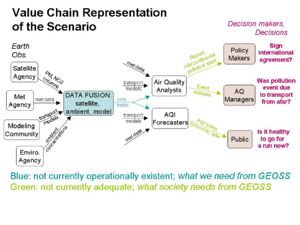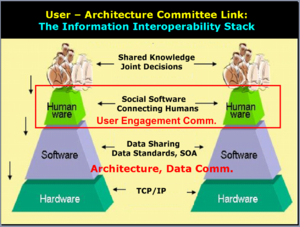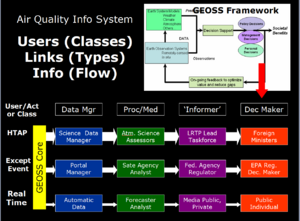2008-05-05: UIC/ADC Air Quality Scenario Workshop
2008-05-09: GEOSS User Interface Meeting, May 5-8, Toronto
The next round of the GEOSS Architecture Implementation Pilot will include an Air Quality scenario, which will include activities pertinent to both the GEOSS Architectural Data Committee (ADC) as well as the User Interface Committee (UIC). This workshop was organized to define the UIC-related topics in connection with the AQ scenario.
Workshop Agenda for 5-May-08
- 9:00 Welcome and Introduction - Ellsworth LeDrew
- 9:15 Overview by UIC - Gary Foley and Ellsworth LeDrew
- 9:45 Overview by ADC - Jay Pearlman and Hans-Peter Plag
- 10:15 Break
- 10:45 Scenario Introduction - David McCabe: The GEOSS AIP Air Quality Scenario
- 11:25 Development of 'working groups' - Rudolf Husar: Users, Applications and the Community of Practice for the Air Quality Scenario
- 12:00 lunch
- 13:00 working group' interaction
- 15:00 Interval assessment - Gary Foley Chair
- 15:30 break
- 16:00 Re-engage 'working groups'
- 17:00 Plenary Assessment - Ellsworth LeDrew, Chair
- 18:00 End
UIC Workshop Feedback on Scenario
- GEO/GEOSS is primarily a global initiative, hence the global policy and assessment aspects of the AQ Scenario are more relevant than the short-term local and individual oriented aspects of the scenario.
- Health impact is a common feature of the air quality sub-scenarios and should be considered.
- The impediments to data flow and open data-sharing principles in the AQ Scenario should be facilitated by UIC.
- A Committee on Earth Observation Satellites CEOS for land observations should be promoted as part of the scenario.
AQ Scenario Workshop Report to the UIC Plenary
McCabe Report to the UIC Plenary
- We focused the discussion of the scenario on three decision-making Users:
- Policymaker: Policymakers who will negotiate international agreements on intercontinental pollutant transport
- Manager: Air Quality officials who determine whether pollution events meet 'exceptional event' standards, i.e., whether it can be demonstrated that exceedences of air quality standards were due to transport of pollution from a distant fire, dust storm, etc.
- Public: Sensitive individual who need Air Quality information to make activity decisions
 These examples help to make the scenario more concrete. One key is that, several steps upstream in the value chain, these users all depend on the same data, tools, and information.
These examples help to make the scenario more concrete. One key is that, several steps upstream in the value chain, these users all depend on the same data, tools, and information.
Husar Report to the UIC Plenary
Background on AQ Scenario
On 5 May 2008, the day before the GEO UIC meeting, there will be a side meeting on the Architecture Implementation Pilot (AIP) AQ Scenario. From a GEO point of view, this meeting has two primary functions:
- The AQ scenario will be used to inform the GEO architecture and data standards communities about user needs for GEOSS. What do AQ users need from the GEOSS registries? from interoperability standards?
- Other societal benefit areas (SBAs) will be developing scenarios, in a parallel process aimed with similar goals. The AQ AIP is serving as a model for that process.
The AQ session side session will introduce the AQ scenario to participants from the GEO UIC and ADC. Participants will then be asked to form small groups of actors, role playing the scenarios, to document what users need from the GEOSS registry and standards.
Development of this scenario also builds the AQ Community of Practice.
The air quality scenario is very broad, intentionally pushing the capabilities of GEOSS. It requires interoperability and stability over different time scales and for many different users, e.g.:
- Air quality and public health managers, needing near-real-time data and forecasts
- The public and other decision makers, also needing nowcasts and forecasts, but in different formats
- Policy makers and scientists needing quality-assured data, model outputs, re-analysis data, etc.
This is not a 'demo' but a push for a broad infrastructure.
It is important for us to keep in mind that the AQ scenario is a tool to help GEO participants flesh out GEOSS through the eventual call for participations, etc. As such, it needs to be clear to folks from well outside the AQ community!!
RHusar Comment:
- GEOSS is focused on architecture (registering services and data); no equivalent approach for the people connectivity(humanware, community of practice?)
- GEOSS is composed of autonomous activities. The isolation of these activities and the lack of transparency/visibility makes it difficult to create sharing, reuse, collaboration...
- Question to the ESIP AQ: How can we promote the mutual support of various voluntary GEOSS activities?...Possible steps:
- Start with mutual awareness of existence, activities....a role for the AQ Cluster? (e.g. Arctur connecting to the Cluster)
- Begin collaboration by openness, sharing of respective resources... the Cluster as a role model? Initially, benefit is by giving to GEOSS something you were already doing in open space. Consequently reap benefits shared content as well, so that you can build on and with others' work.
- Pursue common goals through coordinated activities ... e.g. AIP Scenario development including ESIP-AQ; EPA/NASA; GEOSS ADC; UIC and other stakeholders
- Suggest broadening 'User' to include 'Stakeholders'. More elaboration follows..

